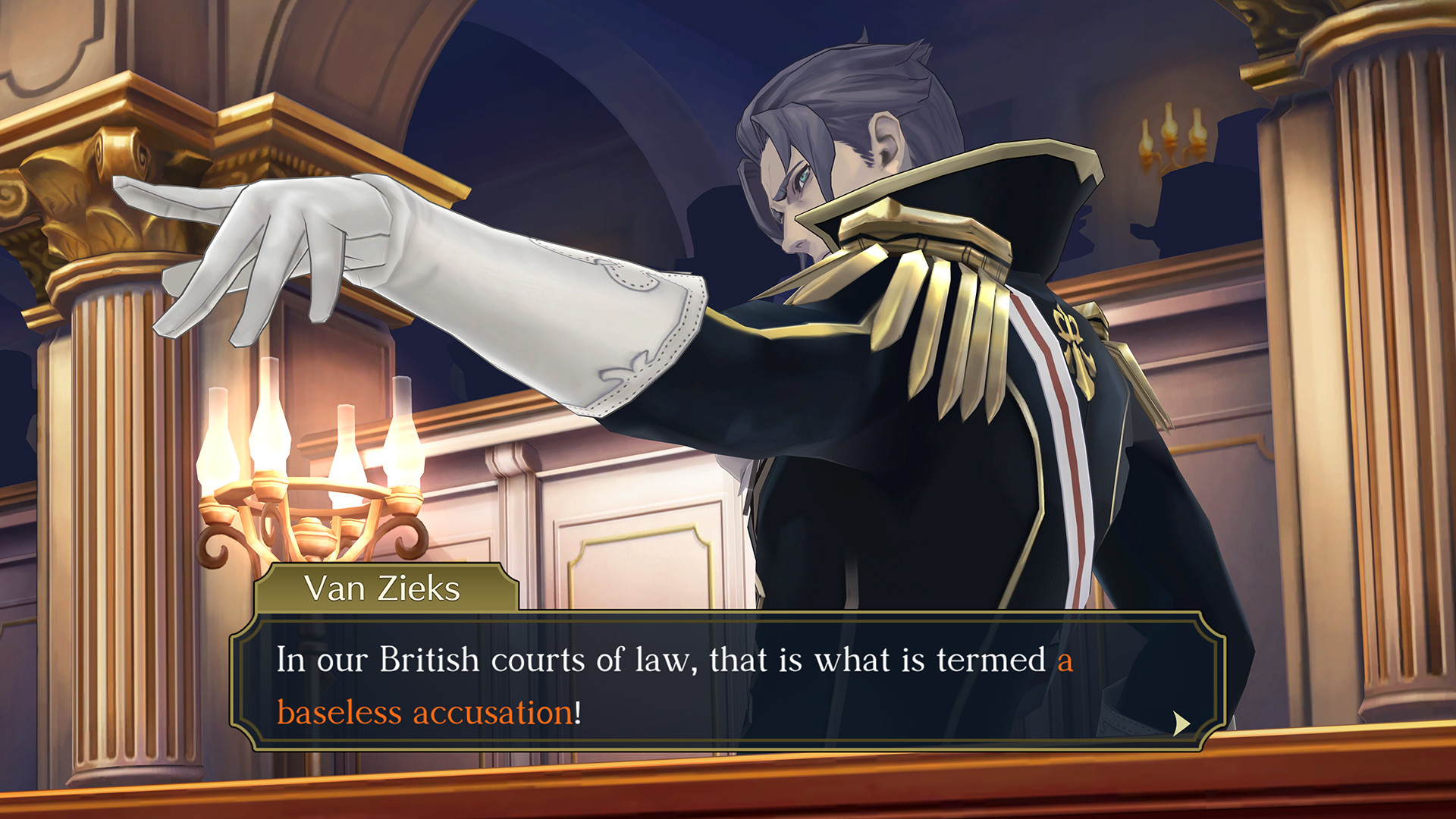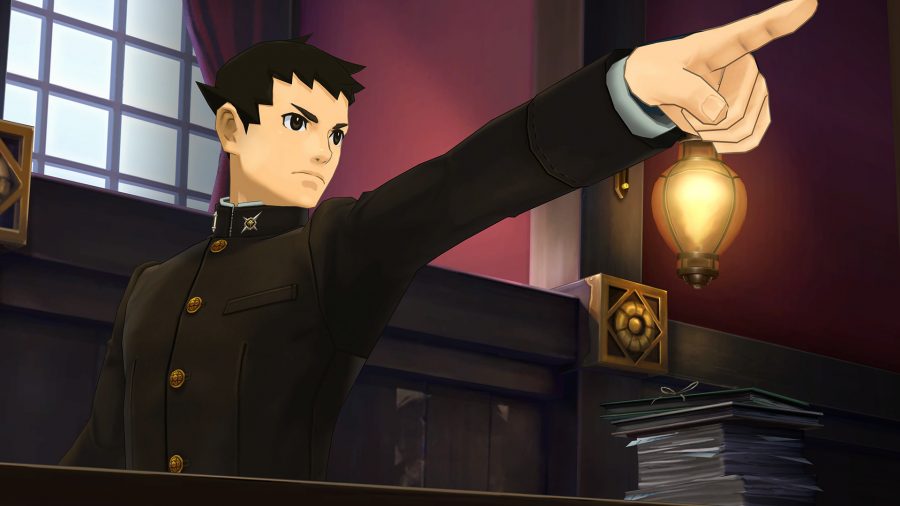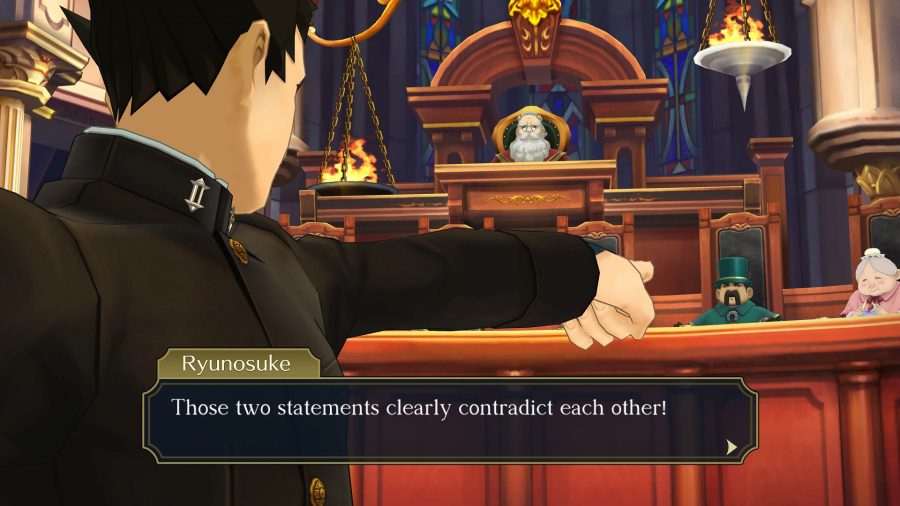The Ace Attorney series is well known for its exaggerated, over-the-top court cases. Where else could you search for the Loch Ness Monster, solve a twenty-year-old murder case, and cross-examine a parrot all in the same case? Certainly not in a real world courtroom.
But in The Great Ace Attorney Chronicles, launching today on Steam, PlayStation 4, and Nintendo Switch, the series leaves behind its modern-day setting and instead transports players back to Victorian-era Britain. It’s a big change for the series, introducing new gameplay concepts both in and out of the courtroom, and raising even more questions about how true-to-life the judicial proceedings are.
We’re no experts on law no matter the era, so we turned to a professional for help to help unpick some of the strange happenings in The Great Ace Attorney Chronicle’s courtroom and shed some light on how accurate these scenes are. We showed them some highlights of the third case of the first game, The Great Ace Attorney Adventures, in which series star Ryunosuke Naruhodo suddenly finds himself defending the enigmatic and wildly rich Magnus McGilded in a murder trial.
 Buy now
Buy nowIsabel Davies is an associate at media law firm Wiggin, specialising in advising gaming companies on contract law, gambling laws, and anything else they need to know to keep their company above board. She’s also a huge gamer, and says that playing the Ace Attorney series as a teenager may have indirectly pushed her towards a career in law.
“I did law at university, and I thought, wouldn’t it be really, really cool if I could basically merge my love of games with a legal career,” she tells us. After graduating and working for legal teams at Disney Interactive and King, Davies went on to join Purewal & Partners, which was eventually acquired by Wiggin, and became a fully qualified lawyer three years ago after many years of on-the-job training.
Her journey to full-fledged lawyer certainly took longer than Ryunosuke’s, who arrives in Great Britain and is almost immediately given the right to practice law – so long as he can successfully win the trial.
It’s certainly not a traditional approach, but Davies believes there’s a kernel of truth in there. “[In Japan] during the Meiji era, when Ryunosuke was operating, attorneys were only just becoming a regulated profession, so it’s quite possible the requirements would have been somewhat looser for him.”
And while Victorian Britain was tightening up its legal processes, Davies notes that “it’s possible that Ryunosuke impressing the right people would have helped him” to secure his right to be a lawyer in the country.
Not that having a lawyer to defend you was particularly common. Davies tells us that during this period, defendants would usually defend themselves in court, rather than going to the expense of hiring a lawyer – except if their sentencing could be the death penalty, as in this trial.
Ryunosuke arrives at the Old Bailey with no clue about the trial, and no evidence to support him. Indeed, it’s only after the trial has begun that the prosecutor begins handing over any evidence to the judge, including the autopsy report and a photo of the crime scene.
This is common across the Ace Attorney series, with prosecutors and witnesses turning in new pieces of evidence as the trial proceeds. In real life, both the prosecution and defence would have time to study all the evidence before the trial even begins. But Davies notes that now the series has come to Victorian London, this might not be so fanciful after all.
“Nowadays, you would not be able to do that 99.9% of the time, you kind of have to disclose everything in advance that you’re planning to fight your case over,” she says. “Whereas, back in the Victorian era, they would have done this. The defendant would have literally come up to the stand and said, ‘I don’t know what evidence they’re going to throw at me!’ Carrying that across from the present day to the Victorian era works really well, and it’s actually pretty accurate.”
Another series staple is cross-examination, where the player needs to listen to witness testimony, press them for more information, and present contradictory evidence to expose their mistakes and lies. Not only is it one of the cores of Ace Attorney, it’s also pretty accurate to how a court case would have run, according to Davies.
“If you were lucky enough to have a defence lawyer fighting in your corner, the main thing they would have been doing is cross-examining the witnesses,” she tells us. “Essentially, your main way of getting out of a case, at this point, was throwing doubt onto the witness testimonies. And particularly in Victorian times, witnesses might have been bribed, or they might have had other motives.”
In previous Ace Attorney games, whether your client was guilty or not would come down to the judge, and their verdict alone would decide how the case ended. But in The Great Ace Attorney Chronicles, you’ll instead be appealing to a jury of six people, who must all come to a unanimous agreement before the case can be decided.
That whole system rings true, but their voting system – which involves them interrupting proceedings to throw a ball of fire into the Scales of Justice – is sadly missing from real-world courtrooms. Davies jokes that it’s something she could “only hope would be in court… it definitely adds a level of gravitas to the proceedings!”
It’s not the only inconsistency, however. Anyone who’s watched a courtroom drama will know that the jury don’t usually brazenly interrupt the proceedings to announce their decision – that decision is made in a separate room. And while The Great Ace Attorney Chronicles allows a second chance for Ryunosuke through its Summation Examination mechanic, which lets you use the jury’s rationale against them to keep the trial going, there would be no such recourse in a real trial.
All that said, once again the game shows some level of truth. In this case, the jury decides on a guilty verdict before the first set of witness testimonies has even finished. According to Davies, “in the Victorian era this would have happened, they would have had the same jury sat on all day. Sometimes they were rollicking through cases in less than ten minutes, making a decision. So it’s not completely ridiculous that the jury is just like, ‘yeah, we’ve made our mind up.’”
Meanwhile, the Summation Examination mechanic is dismissed at first by the menacing Baron van Zieks, a terrifying cape-wielding, chalice-handling prosecutor known as the Grim Reaper of the Old Bailey. His reasoning is that nobody has used it in 50 years, and it has fallen out of favour in the courts. But Susato Mikotoba, Ryunosuke’s trusty judicial assistant, pushes for its use all the same, having uncovered it in the Encyclopedia of British Law she keeps tucked up her sleeve.
Pushing to use an obscure law to escape certain defeat definitely feels like a British thing to do, and Davies agrees. “Particularly in this era, there was very little actually being done in terms of written laws, a lot of things were being decided through case law. So you might find a really obscure case, and the judge would say, ‘that appeals to me, or this appeals to my particular way of thinking.’ It wasn’t particularly thorough!”
One thing that Davies does mention, however, is the surprising number of women involved in the case. While Susato is absolutely invaluable throughout the case, and the jury features an even split of men and women, Davies pointed out that none of those women would be in the courtroom in the Victorian era.
“[Susato] certainly wouldn’t have been a lawyer – a secretary, at a real push,” she tells us. “It’s not completely unheard of for women to have jobs at this time, but it seems quite ballsy that she’s just rolling around court.”
As for the make-up of the jury, “it was nearly always merchants, artisans – people that had some level of standing in society back then. You would sometimes get women called upon if it was a very specific case.”
But overall, The Great Ace Attorney captures the Victorian-era court experience quite well in Davies’ opinion, and the series staples feel better suited to this courtroom than ever before. “They definitely have researched this, you can tell – obviously they’ve changed some stuff… if there’s anything law needs more of, it’s open flames!”
You can find out for yourself just how the game lines up to the real world right now. The Great Ace Attorney Adventures is available on Steam, PlayStation 4, and Nintendo Switch from today, so grab your Encyclopedia of British Law and get down to the courtroom!
{“schema”:{“page”:{“content”:{“headline”:”Objection! A lawyer examines the truth of The Great Ace Attorney Chronicles”,”type”:”promoted”,”category”:”the-great-ace-attorney-chronicles”},”user”:{“loginstatus”:false},”game”:{“publisher”:”Capcom”,”genre”:”Puzzle”,”title”:”The Great Ace Attorney Chronicles”,”genres”:[“Puzzle”]}}}}




